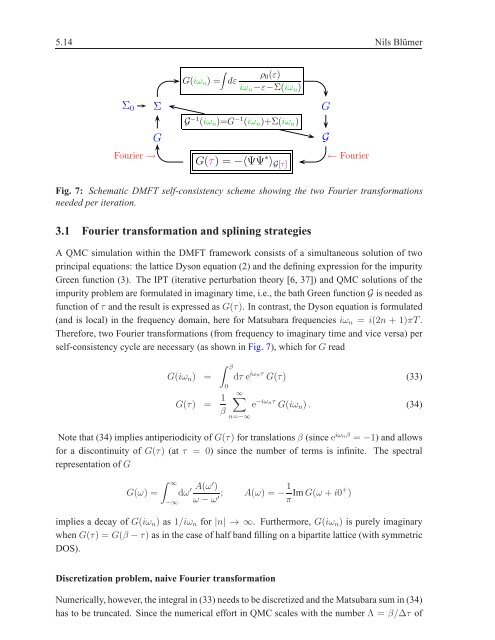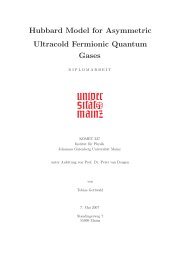5 Hirsch-Fye quantum Monte Carlo method for ... - komet 337
5 Hirsch-Fye quantum Monte Carlo method for ... - komet 337
5 Hirsch-Fye quantum Monte Carlo method for ... - komet 337
Create successful ePaper yourself
Turn your PDF publications into a flip-book with our unique Google optimized e-Paper software.
5.14 Nils Blümer<br />
Σ0<br />
Fourier →<br />
Σ<br />
G<br />
�<br />
ρ0(ε)<br />
G(iωn) = dε<br />
iωn−ε−Σ(iωn)<br />
G −1 (iωn)=G −1 (iωn)+Σ(iωn)<br />
G(τ) = −〈ΨΨ ∗ 〉 G[τ]<br />
G<br />
G<br />
← Fourier<br />
Fig. 7: Schematic DMFT self-consistency scheme showing the two Fourier trans<strong>for</strong>mations<br />
needed per iteration.<br />
3.1 Fourier trans<strong>for</strong>mation and splining strategies<br />
A QMC simulation within the DMFT framework consists of a simultaneous solution of two<br />
principal equations: the lattice Dyson equation (2) and the defining expression <strong>for</strong> the impurity<br />
Green function (3). The IPT (iterative perturbation theory [6, 37]) and QMC solutions of the<br />
impurity problem are <strong>for</strong>mulated in imaginary time, i.e., the bath Green functionG is needed as<br />
function ofτ and the result is expressed as G(τ). In contrast, the Dyson equation is <strong>for</strong>mulated<br />
(and is local) in the frequency domain, here <strong>for</strong> Matsubara frequencies iωn = i(2n + 1)πT .<br />
There<strong>for</strong>e, two Fourier trans<strong>for</strong>mations (from frequency to imaginary time and vice versa) per<br />
self-consistency cycle are necessary (as shown in Fig. 7), which <strong>for</strong>Gread<br />
G(iωn) =<br />
G(τ) = 1<br />
β<br />
� β<br />
dτ e iωnτ G(τ) (33)<br />
0<br />
∞�<br />
n=−∞<br />
e −iωnτ G(iωn). (34)<br />
Note that (34) implies antiperiodicity ofG(τ) <strong>for</strong> translationsβ (sincee iωnβ = −1) and allows<br />
<strong>for</strong> a discontinuity of G(τ) (at τ = 0) since the number of terms is infinite. The spectral<br />
representation ofG<br />
� ∞<br />
G(ω) = dω ′ A(ω′ )<br />
ω −ω ′;<br />
−∞<br />
A(ω) = −1<br />
π ImG(ω +i0+ )<br />
implies a decay of G(iωn) as 1/iωn <strong>for</strong> |n| → ∞. Furthermore, G(iωn) is purely imaginary<br />
when G(τ) = G(β −τ) as in the case of half band filling on a bipartite lattice (with symmetric<br />
DOS).<br />
Discretization problem, naive Fourier trans<strong>for</strong>mation<br />
Numerically, however, the integral in (33) needs to be discretized and the Matsubara sum in (34)<br />
has to be truncated. Since the numerical ef<strong>for</strong>t in QMC scales with the number Λ = β/∆τ of













